Must-Try Foods in Vietnam: Pho Soup, Rice Rolls and Sweet Coffee
Categories: Asia | Food and Drinks
By Pictolic https://pictolic.com/article/must-try-foods-in-vietnam-pho-soup-rice-rolls-and-sweet-coffee.htmlOver the past few years, Vietnamese food has become fashionable in Russia - unusual, satisfying and varied. Here are the most popular national dishes that are worth trying when you are in Vietnam.
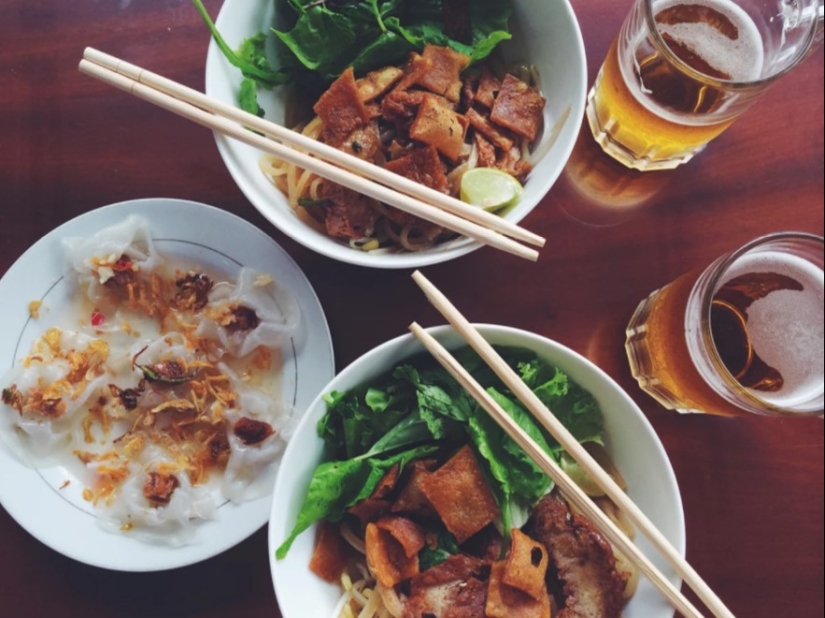
Like many other Asian cuisines, Vietnamese cuisine is all about balance. This is the use of contrasting textures (soft and crunchy) in one dish, a balance between the main tastes: sweet, bitter, salty, sour and hot - a balance of the colors of ingredients, a balance of spices and herbs. Balance is evident even in the harmonious use of heating and cooling elements according to the principles of yin-yang.
Other distinctive features of Vietnamese cuisine are the freshness of food (dishes are usually quickly prepared before serving and are not prepared for future use), the widespread use of vegetables and fresh herbs, and the popularity of dishes with broth.
Typical seasonings for dishes: lemongrass, ginger, coriander (cilantro), Thai basil, mint, lime, Thai chili. Fish sauce, shrimp paste, chili sauce and soy sauce are widely used.
Most Vietnamese dishes are not spicy; chili peppers and chili sauce are usually served separately as additional seasonings. A plate of fresh herbs is served as an accompaniment to many dishes. In Vietnamese cafes and restaurants, it is customary to serve chilled green tea as a welcome drink with any ordered dishes or drinks. White bread is very popular among the Vietnamese as a relic of French colonization, but it is not customary to serve it with soups.
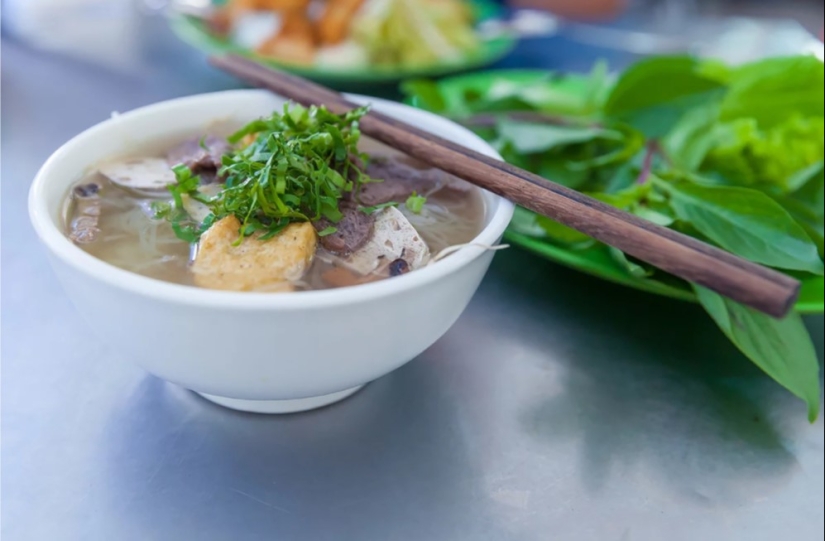
Fish sauce (Nước mắm) and shrimp paste (mắm ruốc, mắm tép, mắm tôm) are used in almost every dish in Vietnamese cuisine. These are quite specific seasonings based on fermented seafood. They are difficult to notice by eye, so they can be a problem for people with food allergies or vegetarians, but this does not mean that you can give up on Vietnamese cuisine.
Due to the widespread use of Buddhism among the Vietnamese, there is a whole layer of monastic cooking that proclaims itself to be pure vegan, that is, it does not use any animal products, including dairy products, eggs and animal fats. In the menu of such cafes you can find the words “chicken” (gà), “beef” (bò), “fish” (cá), “shrimp” (tôm), but here we mean their vegetarian substitutes.
It is quite easy to identify a cafe serving vegetarian Vietnamese cuisine by the sign Cơm Chay (kom chay), which translates as “vegetarian food”. Often such establishments can be found next to Buddhist temples.
Once in Vietnam, it is easy to get confused by the variety of exotic dishes. Let's look at the most popular and interesting dishes of Vietnamese cuisine that are worth trying.

The calling card of Vietnamese cuisine and probably one of the most famous Vietnamese dishes. In truth, Phở is the name of the flat rice noodles that Phở noodle soup is made from. Other dishes with these noodles also contain the word Phở, such as Phở xào bò (fried pho noodles with beef). But let's get back to the soup.
The broth version of pho noodles is the most popular among both Vietnamese and visitors. The basis of pho soup is a strong broth seasoned with beef (Phở bò), chicken (Phở gà) or vegetable (Phở chay). The aromatic spicy broth is prepared in advance; just before serving, dry noodles are scalded, chopped pieces of meat or tofu, vegetables are added, and all this is poured with boiling broth. A bowl of pho is served with fresh herbs (usually basil), lime, chili peppers, soybean sprouts and sometimes a thick sweet and sour sauce. All this should be added to the plate according to your taste. Pho is eaten with chopsticks and a spoon. Pho is prepared in cafes and restaurants, as well as simply on the street in pots over coals. Simple street eateries with small plastic chairs and tables are almost as recognizable a picture of Vietnam as a Vietnamese tricorn hat.
It remains to add that pho is not the only noodle soup in Vietnamese cuisine. Each region has its own variations of soups. Among the most popular across the country: Bún bò Huế - a spicy soup with round rice noodles (usually beef, but there are also vegetarian options), Mì Quảng - a soup with yellow thin noodles, sausages and peanut topping.

Famous Vietnamese sandwich. It is distinguished from simple bread with meat and made famous by several features. Firstly, the use of a large number of herbs and vegetables (cucumber, coriander, onions, pickled carrots, white radishes, green onions, fresh chili - the set may vary slightly), secondly, the use of one or more sauces (sweet chili, soy sauce, mayonnaise, butter with green onions and others), thirdly, before preparing the correct banh mi, the white bread is lightly fried over coals.
There are many variations of the main filling for banh mi: smoked meat, pate, sausages and sausages, even canned sardines, processed cheese or a combination thereof. Banh mi is usually prepared by vendors in mobile street stalls, although it can sometimes be found on cafe menus.
Banh mi is considered a snack in Vietnamese cuisine; it is usually eaten between main meals, always wrapped in newspaper. We eventually got used to making our own banh mi at home, using only the ingredients we liked.

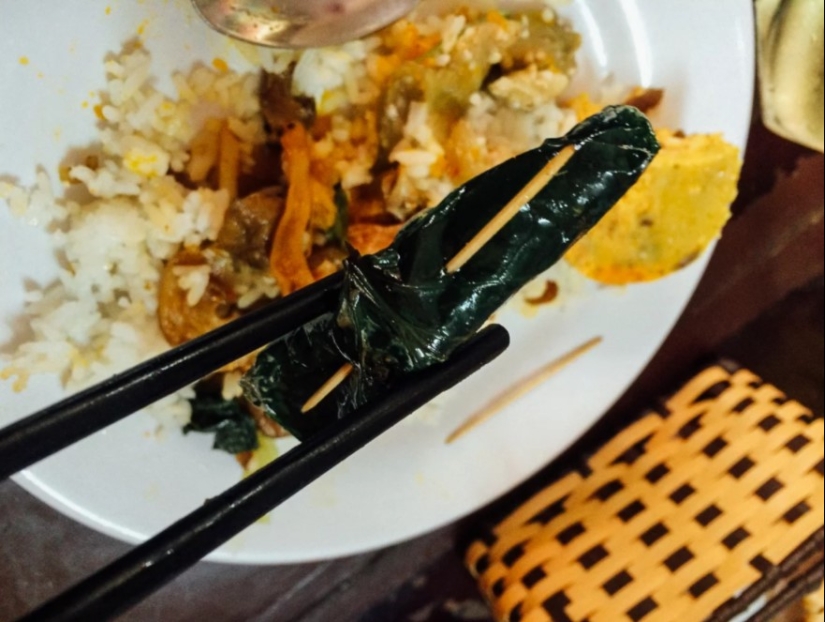
Rolls are rice paper rolls with various fillings. There are lettuce rolls (Gỏi cuốn), sometimes called “summer” rolls, and fried crispy “spring” rolls (Nem rán or Chả giò - they are called differently in the south and north), known as spring roll. roll).
Salad rolls are wrapped in moistened rice paper and served raw. The filling uses fresh herbs and vegetables, vermicelli, shrimp and meat. Vegetable versions of salad rolls are usually found in vegetarian (Cơm Chay) cafes. Rolls are served with dipping sauce. These rolls are quite large in size, unlike fried spring rolls. Two to four pieces are enough for one serving.
Spring rolls are fried until crispy and also served with sauce. They are much smaller in size than summer ones; the usual serving size is four to six pieces. The spring roll filling may contain meat, mushrooms, noodles, kohlrabi cabbage, and local root vegetables. Purely vegetable spring rolls are often found in ordinary cafes. All rolls in Vietnamese cuisine are usually eaten as an appetizer, in addition to the main course.

Bo lalot is not as famous as previous examples, but it is a very popular dish of Vietnamese cuisine among Vietnamese and visitors. This is a kind of snack cooked over coals. You will regularly see roasting pans with strange green rolls on the streets of Vietnam.
The dish consists of ground beef with seasonings, wrapped in the leaves of the lolot pepper plant and baked over charcoal. Its main highlight is the bright, hot, spicy taste of the Lolot leaf: a little tobacco, a little lemon, a little pepper. We even came across this dish in a vegetarian cafe (Quán cơm chay Bồ Đề, 62-64 Huỳnh Thúc Kháng, Nha Trang), and it became one of my favorite Vietnamese snacks. Bo lalot is definitely a dish worth trying in Vietnam.
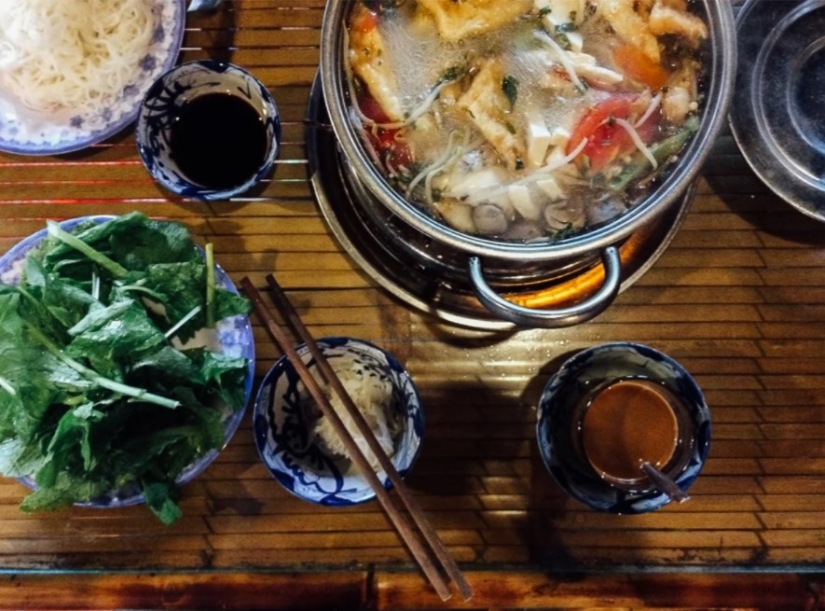
Banh bao is a steamed bun made from yeast dough with various fillings. This is a dish of Chinese origin, popular in Vietnam. Essentially, these are our pies, only steamed. The classic filling of buns in Vietnamese cuisine is pork and egg, but there are also vegetable and sweet options.
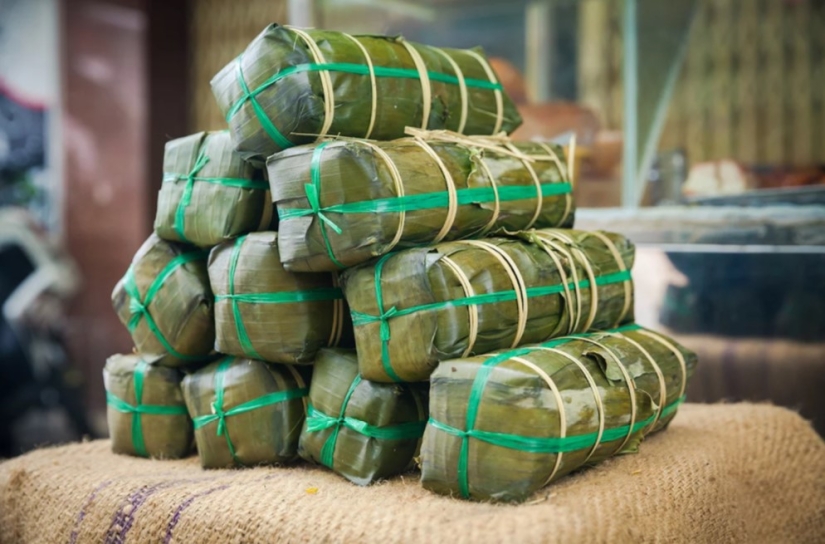
Lẩu or Hot-pot (hot pot) is a dish of Mongolian-Chinese origin, known throughout Asia. What is interesting about it is not so much the taste as the way it is served and consumed. Hot pot literally means “hot pot.” When serving lou in Vietnam, a burner is placed in the center of the table, on which a pot of boiling broth is placed. The broth is cooked in advance, but in addition to it, various additives are served that can be thrown into the boiling broth and cooked right on the table. These can be pieces of meat, mushrooms, seafood, vegetables, and herbs. The dish is also served with sticky rice noodles, which you do not need to boil, but put on your plate and pour hot pot broth over it, or simply eat as a bite with toppings.
Lowe is a dish for a group; it’s quite difficult for two people to handle it. For the Vietnamese, Lẩu is one of the favorite ways to spend time with family or friends and celebrate an important event.
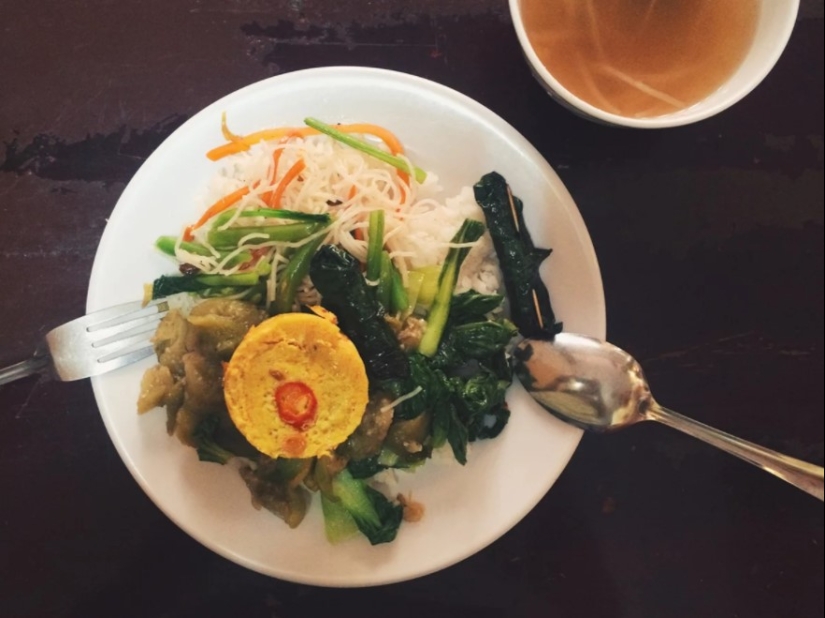
Ban Tiung is a roll of sticky rice cooked in banana leaves and stuffed with mung beans, pepper, salt and pork. It is a pillar of Vietnamese cuisine, although it is not as famous outside of Vietnam as pho soup. Banh Tiung is a traditional dish of the Vietnamese New Year Tet (Bánh tét), but can also be eaten at other times of the year. There are vegetarian and sweet versions of the roll.
Preparing traditional ban tiung is a labor-intensive and time-consuming process; cooking takes 10-12 hours, and approximately the same amount of time for preliminary preparation. In addition to banh tiung, in Vietnam you can often find similar dishes of Vietnamese cuisine in banana leaves, the basis of which is glutinous rice (small rolls with fillings, sweets).
Banh seo is a rice flour pancake fried in oil with shrimp, onions, and sometimes mushrooms. Served with lettuce, bean sprouts, herbs and dipping sauce.

The daily food of most Vietnamese is Cơm Đĩa, which literally means “rice bowl”. This dish is worth trying if you want to understand what the Vietnamese eat in everyday life for breakfast, lunch and dinner, in addition to pho and other soups. The basis of Cơm Đĩa is boiled rice, on which many different fillings are placed. Usually these are three or four types of vegetables and several types of meat (in the vegetarian version, soy and mushrooms). Often cafes are organized like a canteen, so everyone can choose toppings to their liking. It is customary to serve a bowl of warm broth with a plate of Cơm Đĩa. In Vietnamese cuisine, there are a number of dishes similar to Com Dia - for example, Cơm tấm (rice with several types of pork and vegetables), Cơm gà (rice with chicken), Cơm vịt (rice with duck).
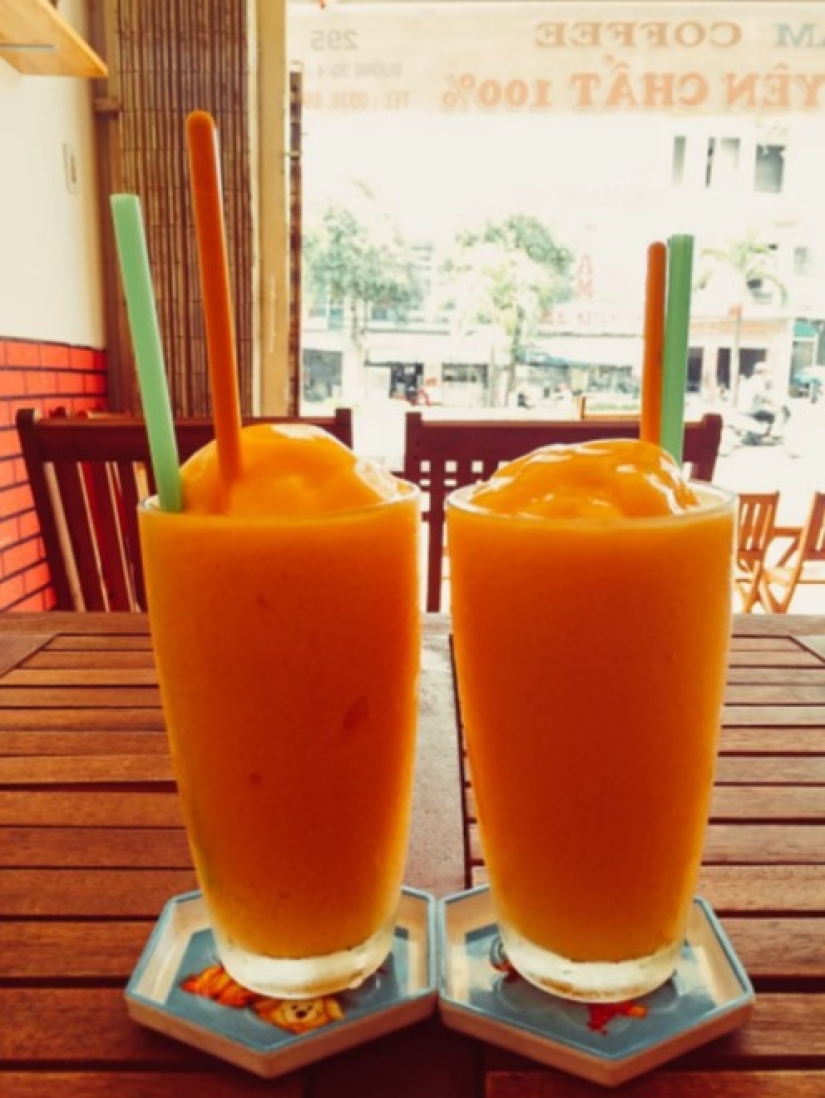
Drink, pudding, sweet soup - it is difficult to find an exact definition of the Vietnamese dessert Che. Chè may include beans, jellies, fruits, lotus seeds, sesame, coconut, tapioca, rice, taro, corn and other foods, topped with sweet coconut cream or sweet syrup. Most often, cheese is eaten cold from a glass or plastic cup. It is sometimes served in bowls with a spoon, like soup.

Sinh tố is a Vietnamese version of a smoothie, a thick and sweet fruit drink shaken with ice. In Sinh tố, in addition to fresh fruit and ice, they can add yogurt, condensed milk, sweet syrup, or all of these together. A good Sinh tố has the consistency of a delicate melting sorbet and a pronounced fruity taste.
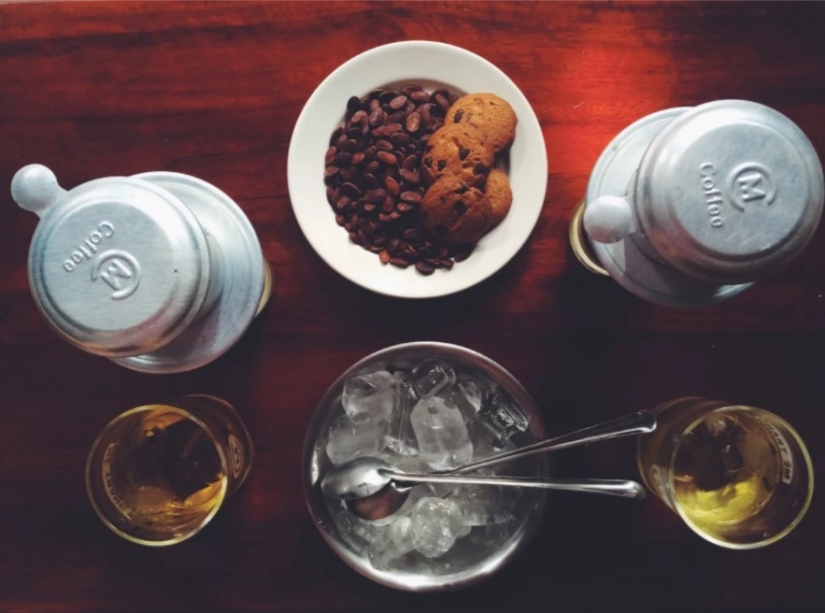
Last but not least is Cà phê, the famous Vietnamese coffee. If you drink coffee, then it's definitely worth trying. Vietnam is the second largest coffee producing country in the world after Brazil, although most of the coffee beans are Robusta. The Vietnamese prefer a very dark roast, which makes their coffee quite bitter. But Vietnamese coffee is not so much about the beans as it is about the way they are prepared. To brew Vietnamese coffee, drip filters (phin cà phê) are used, which are installed on the mug. Sometimes coffee is brewed in advance (especially when served with ice), in such cases the mug or glass is served immediately without a filter.
The second feature of Vietnamese coffee as a drink is that it is always sweet. Sweetness is used to balance the strong bitterness of coffee, and it turns out quite well: coffee with condensed milk acquires chocolate and waffle notes, and black coffee acquires notes of cognac. If you want unsweetened coffee, you should say this in advance, as sugar is always added. It is also worth keeping in mind that coffee with milk in Vietnam usually means condensed milk. If you want regular milk, then you need to say fresh milk (“fresh milk”, fresh milk). Vietnamese coffee is served with green tea, and tea is added without restrictions. In Vietnam, it is not customary to binge on coffee, so coffee shops usually do not have food or desserts.
The most popular types of Vietnamese coffee: Cà phê sữa (ca phê sữa, hot coffee with condensed milk), Cà phê (ca phê, black hot coffee with sugar), Cà phê đá (ca phê da, black coffee with sugar and ice; ice can be served separately so that you add it to the glass yourself, or the coffee is mixed with ice in a shaker, which creates a thick coffee foam), Cà phê sữa đá (cà phê sữa đá (ca phê sữa da, coffee with ice and condensed milk, can also be mixed in a shaker or served separately with ice).
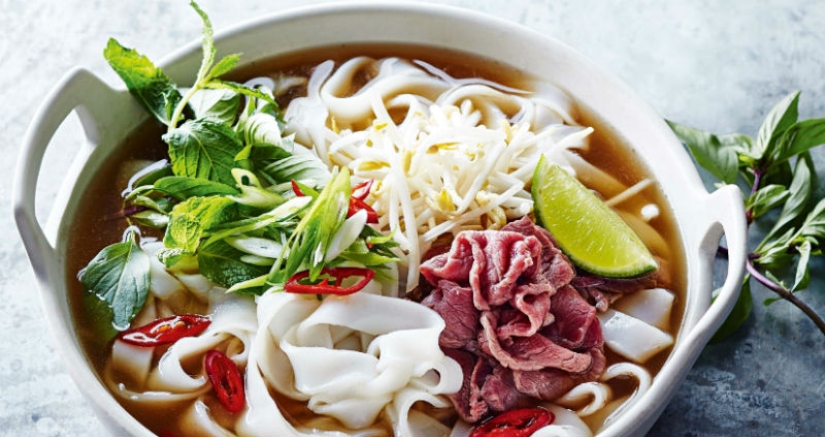
Recent articles

Victor Lustig is considered one of the most skillful and famous scammers in the world. He was arrested about 50 times and released ...

A small apartment is not a sentence! On the contrary, this is an occasion to turn on imagination and come up with ways to stylishly ...

Each of us has heard at least once that "breakfast is the most important meal of the day." Spreading this truth is the work of ...